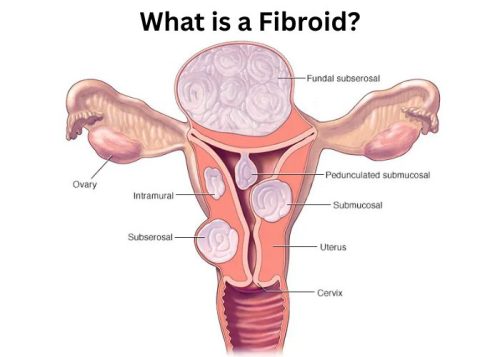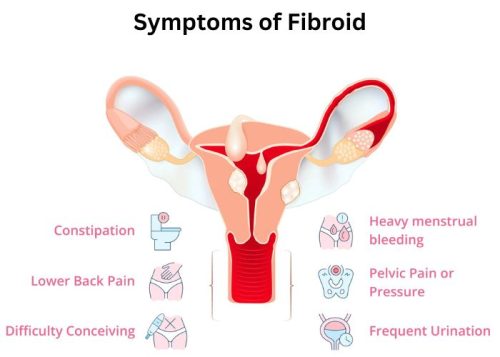
Fibroids: Types, Symptoms, and Causes
Fibroids are benign growths that develop within or around the uterus, typically during reproductive age. Some women do not experience any symptoms, while others will experience pain, profuse bleeding, or infertility. This blog tells about what a fibroid is, what the types of fibroids are, symptoms, causes, successful homeopathy medicine for fibroids, prevention tips, and complications associated with fibroids simply and lucidly.
What is a Fibroids?
Fibroid or uterine fibroma refers to a non-cancerous (benign) growth occurring in the muscle wall of the uterus. Uterine fibroma consists of fibrous and muscle tissue. Fibroids can range in size from a small seed to a large mass that can prolong or increase the uterus to a great extent.
Uterine fibromas are found to be exceedingly common. Approximately 70–80% of women are reported to develop uterine fibroma at some point, but not all present with symptoms.

Types of Fibroid
Fibroids are differentiated according to their site in or around the uterus. Knowledge of fibroids’ types assists in diagnosing the condition and selecting the appropriate treatment. The following are the principal types:
Intramural Fibroids
They are the most frequent types. They develop in the uterine muscle wall. When they increase in size, they might make the uterus become larger than usual and resulting in heavy menstrual bleeding or pelvic discomfort.
Subserosal Fibroids
These form on the outer surface of the uterus and may grow outward into the pelvic cavity. They can become large and push against other organs such as the bladder or rectum, leading to constipation or frequent urination.
Submucosal Fibroids
Located just beneath the inner lining of the uterus (endometrium), these are rarer but can lead to heavy menstrual bleeding and can result in fertility problems or recurrent miscarriage.
Pedunculated Fibroids
These fibroids are attached to the uterus by a thin stalk or stem and can grow inside or outside of the uterine wall. They can grow inside the uterus as submucosal uterine fibroma or outside as subserosal uterine fibroma. When twisted, they can produce severe pain and may need immediate attention.
Cervical Fibroids
These fibroids grow in the cervix, the lower part of the uterus that connects to the vagina. However rare, they can lead to urinary problems or complications of delivery.

Symptoms of Fibroids
Most women who have fibroids experience no symptoms. When symptoms do occur, they will vary depending on the size, number, and location of the uterine fibroma. The usual symptoms of uterine fibroma are:
- Heavy or long periods
- Pelvic pain or pressure
- painful intercourse
- More frequent urination or failure to empty the bladder
- Constipation
- Backache
- Bloating or a full sensation in the abdomen
- Trouble conceiving or recurrent miscarriage
If you experience any of these signs, seek advice from a medical practitioner for examination.

Causes of Fibroids
The precise causes of fibroids are yet to be understood, but various factors have been known to contribute to the development of fibroids. They are affected by hormonal, genetic, and lifestyle factors. These are the principal factors responsible for the development of uterine fibroma:
Hormonal Imbalance
Estrogen and progesterone, the two significant female hormones, stimulate the development of the lining of the uterus throughout the menstrual cycle. Uterine fibromas have a higher number of estrogen and progesterone receptors than regular uterine muscle cells, which might be the reason behind the rapid growth of fibroids in reproductive ages and regression after menopause.
Genetic Factors
Fibroids tend to be hereditary. If your mother, sister, or grandmother had uterine fibroma, your chances of developing them may be higher.
Obesity and Excess Body Weight
Increased estrogen levels in the body due to being overweight can help grow fibroids.
Early Menstruation
Early onset of menstruation is associated with increased lifetime exposure to estrogen, which can increase fibroid risk.
Diet and Nutrition
A fruit-poor, vegetable-poor diet with a high component of red meat or fast food can increase fibroid risk. Vitamin D deficiency is also implicated in fibroid growth.
Stress and Lifestyle
Chronic stress can impact hormone balance, with a potential result of causing fibroid growth or exacerbating them.
Environmental Toxins
Exposure to some chemicals with estrogen-like qualities (such as those used in plastics or pesticides) could, over time, lead to the development of fibroids.
Even though you can’t alter certain risk factors, such as genes, having a healthy lifestyle will decrease the chances or delay fibroid growth.

Homeopathy Medicine for Fibroids
Varied remedies can be prescribed depending upon the symptoms and constitution of the patient. Some of the popular homeopathic remedies for fibroids are:
Calcarea Carbonica
Beneficial in women who have a heavy period and gain weight, especially those who are cold and tired.
Sepia
Useful in those cases involving pelvic pain, mood swings, and menstrual abnormalities.
Lachesis
Helpful for women experiencing a sense of fullness, tightness, or pressure in the lower abdomen.
Thuja Occidentalis
Usually applied when fibroids are uncomfortable and there is a history of repressed feelings or infections.
Phosphorus
Helpful in cases of heavy bleeding and weakness.
Disclaimer
This article is for informational purposes only. Always consult your physician or a qualified homeopathy practitioner before initiating any treatment.
Prevention of Fibroids
Although fibroids cannot always be avoided, some healthy lifestyle practices can help lower the risk. The following are some tips on how to prevent uterine fibroma:
- Maintain a healthy weight
- Follow a balanced diet rich in green leafy vegetables, fresh fruits, and whole grains to support hormone balance and reduce fibroid risk.
- Avoid processed foods and red meat
- Exercise regularly to stabilize hormones
- Deal with stress through yoga, meditation, or breathing exercises
- Have sufficient vitamin D through sunlight or supplements
- Regular health check-ups for early diagnosis
Complication of Fibroids
Most fibroids are benign, but occasionally, they may lead to serious illness. Some complications of fibroids are:
- Heavy menstrual bleeding and severe anemia
- Infertility or infertility difficulties
- Miscarriage, premature delivery, or labor issues during pregnancy
- Urinary and bowel symptoms
- Sometimes, a fibroid will increase in size rapidly or present suddenly with pain from twisting (if the fibroid is pedunculated)
- Avoiding these complications can be done through early diagnosis and effective treatment.
Consult with Dr. Deepika
Dr. Deepika, the best homeopathy doctor in Noida, provides personalized care for women with fibroids. She takes a personalized treatment approach and treats fibroid symptoms naturally with effective and safe homeopathy medicine for long-term hormonal balance.